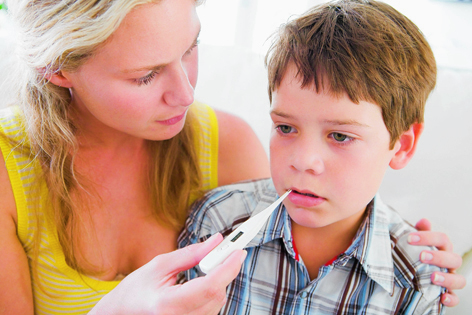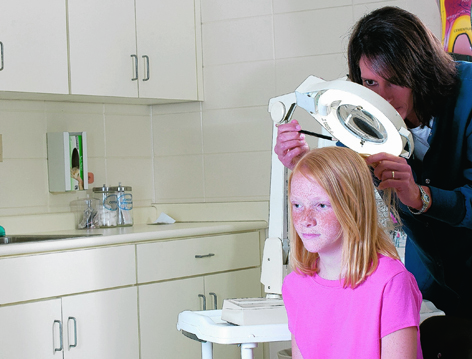New school year, new set of bugs to contend with. We swot up on the childhood illnesses that thrive in class, and how to tackle them.
The new school year is about to start, and soon children up and down the country will be back in the classroom – those breeding grounds of knowledge and creativity. But, steel yourself parents, they’re also prime breeding ground for the lurgy.
All parents know that while gold stars might not be guaranteed, it’s a safe bet that your child will bring at least a couple of bugs home from school and often, there’s nothing they can do about it.
However, consultant paediatrician Dr Markus Hesseling, a spokesperson for the Royal College of Paediatrics and Child Health, points out that most illnesses caught at school are minor.
He says: “Simple illnesses like gastroenteritis, and respiratory problems like chest infections are a bit more frequent after school starts, simply because children have been sharing their bugs with a very small population over the summer holidays, and at school there are loads of susceptible friends to catch them.”
Dr Hesseling adds: “Take general, sensible measures like washing hands when you’ve been to the toilet or sneezed – nothing new, just commonsense.”
Thankfully, the majority of the time, these illnesses are not serious, and some don’t even require treatment. But, err on the side of caution if you are concerned and call your doctor. As Dr Hesseling points out: “Parents know their children best, and if they feel there’s something seriously wrong they need to get them seen, sooner rather than later, instead of thinking it’s just because they’re back at school.”
Here’s a look at some of the most common classroom bugs.
COLDS AND FLU
Always top of the league tables is the common cold, and kids are more prone than adults – it’s estimated they get eight or more a year. But aside from soothing the symptoms, there’s not a lot parents can do. Flu can make kids quite poorly, but it usually isn’t serious unless there are complications, or a child has certain pre-existing health problems.
“Parents need to teach them how to cope with minor illnesses,” says Dr Hesseling. “There are obviously cases where flu can become a real problem, for example, in immunocompromised children, but generally healthy children can fight the illness off without major support – mostly parental TLC, a bit of paracetamol, plus plenty of fluids.”
GASTROENTERITIS
Tummy bugs caused by viral or bacterial infections, are another common term-time affliction. The main symptoms are diarrhoea and vomiting, which usually clear up in five to seven days. The most common cause in children is a virus called rotavirus, which can be transferred to food, objects and surfaces if infected children don’t wash their hands after going to the toilet.
It’s important to ensure your child doesn’t become dehydrated by giving them plenty of fluids (avoiding fruit and fizzy drinks). If symptoms are severe, or if vomiting continues for more than three days – or diarrhoea for more than a week – consult a doctor.
MEASLES, MUMPS AND RUBELLA
Measles mumps and rubella (German measles) are highly infectious and can have serious, potentially fatal, complications, including meningitis, encephalitis (swelling of the brain) and deafness.
They can also lead to complications if a pregnant woman becomes infected. With measles and rubella, the most obvious symptom is a rash, and with mumps there’s facial swelling and pain. Feeling unwell and a high temperature occur in all three illnesses.
As recently as last year there were measles outbreaks in the UK, as many children weren’t vaccinated following Dr Andrew Wakefield Nineties report suggesting the MMR jab was linked to autism and bowel disease.
The report has since been discredited, and catch-up vaccination programmes have ensured uptake of the vaccine has increased.
If you do suspect your child has measles, mumps or rubella make an appointment with your doctor ASAP. Call first though, to avoid infecting people in the waiting room.
CHICKEN POX
Chicken pox is usually a mild illness, and is extremely common. It starts with children feeling unwell, a slight temperature and a rash, which turns into itchy spots and then fluid-filled blisters which dry into scabs.
Scarring shouldn’t occur if scabs are not scratched. Treatment is giving plenty of fluids, paracetamol or ibuprofen to relieve fever and discomfort, baths, dressing them in loose comfortable clothes, and calamine lotion to help ease itching.
This is another illness that can cause complications in pregnant women, so it’s important to isolate children until they’re not infectious (when the blisters scab over).
Although there is a chickenpox vaccine, it’s not part of the UK childhood vaccination programme and is only used to protect people who are most at risk of serious complications.
HEAD LICE
Head lice don’t make children ill, but they can be extremely uncomfortable. Lice are very common in children aged between four and 11, with an estimated one in three becoming infected during the school year, though most cases aren’t reported.
The sesame seed-sized, grey-brown nasties can’t swim, jump or fly; they’re spread by head-to-head contact and feed off blood from the scalp.
They can be detected with a special fine-toothed comb and often it’s their white, empty egg cases (nits) that are easiest to spot. Medicated lotions, or wet-combing, can help get rid of lice, and regular detection combing is advised to spot and treat lice early.
SCARLET FEVER
Scarlet fever is usually a mild illness caused by streptococcus bacteria. Children with the illness have a widespread pink-red rash, which may be itchy, and may also have a high temperature, sore throat and flushed face.
It can be treated easily with antibiotics. Cool fluids can help soothe the throat and paracetamol can bring down a temperature.
MENINGITIS
One of the illnesses parents fear most is meningitis, an infection of the membrane that surrounds the brain and spinal cord.
Babies and young children are among high-risk groups. Vaccines can protect against many types of meningitis, but not all of them.
Steve Dayman, founder of Meningitis Now, notes that meningitis cases peak in winter, after children have gone back to school, and stresses that awareness of symptoms is vital to ensure the illness is spotted and treated quickly.
“It’s vital that young people know the symptoms, because they are one of the groups most at risk,” he says.
Symptoms include a dislike of bright lights, headache, stiff neck, lethargy and vomiting. Sometimes, though not always, there’s a rash, which is a sign of septicaemia (blood poisoning).

